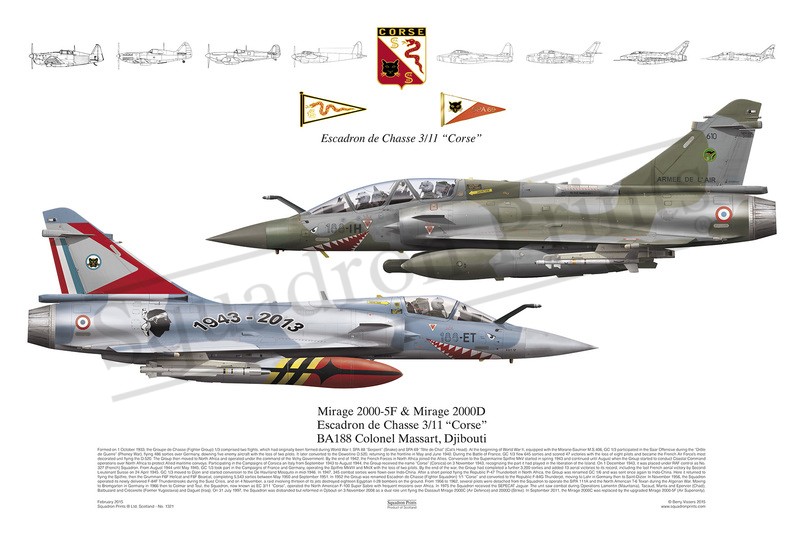#1321 Mirage 2000

Purchased products will not feature the Squadron Prints watermark
Description
Squadron Prints Lithograph No. 1321 - 57 '188-ET;, Mirage 2000-5F, 610 '188-IH', Mirage 200D, Escadron de Chasse 3/11 "Corse", BA188 Colonel Massart, Djibouti.
Formed on 1 October 1933, the Groupe de Chasse (Fighter Group) 1/3 comprised two flights, which had originally been formed during World War I; SPA 88 “Serpent” (Snake) and SPA 69 “Tête de Chat” (Cat’s Head). At the beginning of World War II, equipped with the Morane-Saulnier M.S.406, GC 1/3 participated in the Saar Offensive during the “Drôle de Guerre” (Phoney War), flying 486 sorties over Germany, downing five enemy aircraft with the loss of two pilots. It later converted to the Dewoitine D.520, returning to the frontline in May and June 1940. During the Battle of France, GC 1/3 flew 645 sorties and scored 47 victories with the loss of eight pilots and became the French Air Force’s most decorated unit flying the D.520. The Group then moved to North Africa and operated under the command of the Vichy Government. By the end of 1942, the French Forces in North Africa joined the Allies. Conversion to the Supermarine Spitfire MkV started in spring 1943 and continued until August when the Group started to conduct Coastal Command operations over North Africa to protect Allied maritime convoys. Participating in the Campaigns of Corsica an Italy from September 1943 to August 1944, the Group received the name “Corse” (Corsica) on 3 November 1943, recognizing the part it had played in the liberation of the Island. On 1 December 1943, it was placed under RAF control as No. 327 (French) Squadron. From August 1944 until May 1945, GC 1/3 took part in the Campaigns of France and Germany, operating the Spitfire MkVIII and MkIX with the loss of two pilots. By the end of the war, the Group had completed a further 3,200 sorties and added 13 aerial victories to its record, including the last French aerial victory by Second Lieutenant Suisse on 24 April 1945. GC 1/3 moved to Dijon and started conversion to the De Havilland Mosquito in mid-1946. In 1947, 345 combat sorties were flown over Indo-China. After a short period flying the Republic P-47 Thunderbolt in North Africa, the Group was renamed GC 1/6 and was sent once again to Indo-China. Here it returned to flying the Spitfire, then the Grumman F6F Hellcat and F8F Bearcat, completing 5,543 sorties between May 1950 and September 1951. In 1952 the Group was renamed Escadron de Chasse (Fighter Squadron) 1/1 “Corse” and converted to the Republic F-84G Thunderjet, moving to Lahr in Germany then to Saint-Dizier. In November 1956, the Squadron operated its newly delivered F-84F Thunderstreaks during the Suez Crisis, and on 4 November, a raid involving thirteen of its jets destroyed eighteen Egyptian Il-28 bombers on the ground. From 1956 to 1962, several pilots were detached from the Squadron to operate the SIPA 111A and the North American T-6 Texan during the Algerian War. Moving to Bremgarten in Germany in 1966 then to Colmar and Toul, the Squadron, now known as EC 3/11 “Corse”, operated the North American F-100 Super Sabre with frequent missions over Africa. In 1975 the Squadron received the SEPECAT Jaguar. The unit saw combat during Operations Lamentin (Mauritania), Tacaud, Manta and Epervier (Chad), Balbuzard and Crécerelle (Former Yugoslavia) and Daguet (Iraq). On 31 July 1997, the Squadron was disbanded but reformed in Djibouti on 3 November 2008 as a dual role unit flying the Dassault Mirage 2000C (Air Defence) and 2000D (Strike). In September 2011, the Mirage 2000C was replaced by the upgraded Mirage 2000-5F (Air Superiority).
You may also like
-
Hawk Mk65
8801The Royal Saudi Air Force Aerobatic Team, The Saudi Hawks, 88 SqnTabuk, King Falsal AB -
SALE Tornado, Nimrod, Sea King
201 Sqn; 12 Sqn; 15 Sqn; 617 Sqn; 120 Sqn; 42 Sqn; 202 Sqn 'D'-FlightRAF Kinloss; RAF Lossiemouth
